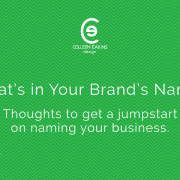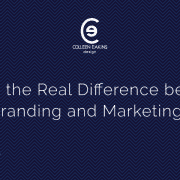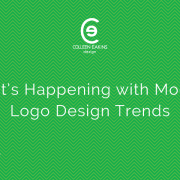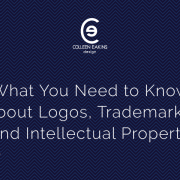What’s in Your Brand’s Name?
Thoughts to get a jumpstart on naming your business.
First Hurdle
Starting a new business is a fun and scary process. For one, you have decided that it’s your goal to offer goods and services that can benefit the masses and that excites you. On the other hand, the energy and work needing to be put in is overwhelming and finding the direction you need to go in can get blurry.
First, building your brand strategy from the business plan you have already developed is a great starting point. After all, the name of your business should be an extension of your brand’s goals and identity. The name chosen, will also be wrapped in how you advertise and market the company to reach the correct audience. Determining the difference between branding and marketing will be helpful in the steps to creating the perfect name.
No Name is a Bad Name
Just as they tell you all throughout school, no idea is a bad idea – you can and should absolutely use this principle when starting to compile potential names for the company.
Inspirations can come from:
Literature
Favorite stories, book titles, and even author’s names are a great place to find inspiration. These stories inspire imagination and possibilities and that does not stop at childhood (and shouldn’t).
Music
Similar to literature, music is a top muse and sparks can be found in how a song makes you feel, song titles, album cover art, and musician & group names. Even specific instruments can be a trigger source.
Names
Do you want to honor who founded the company (yes, yourself – it’s okay!)? Is there anyone in close proximity to the company that can be incorporated? People from every aspect of those connected to the company can be used to draw upon ideas.
Foreign meanings
How does the word in English translate to a different language? Does that language reflect the brand? Does the alternate language hold a special meaning to the founding members or company?
What the service or product does
Sometimes, simple is the best! This means, the intended use of the product can be used for the name of the company. If the service is unique, then possibility that is the name. Every so often not overthinking can create the best outcomes.
Experiences
Have you had an altering experience during the development of creating the item or service? Has there been a past event that could be relatable to your company?
Made up word
Pulled right out of the sky; every now and then it works out for the best! How does an apple relate to a computer?
As the list narrows on selections, there are a few ways to check to make sure that it will be best suited for your brand and company.
How to Check Your Name against the Competition
Finding out that your favorite name has already been taken or is close to a similar type of company, can be discouraging. There are ways to check against those road blocks during the naming discovery process.
Do you find it original?
Did you switch up the spelling of a word, create your own word, or play upon the product with how it’s named? Being original can be difficult and intimidating, but a must for your business. You believe your offering is needed in the market and want to differentiate yourself.
Will it be long-lasting?
Remember to think long-term about your business. Will you reach out to a different market with the product and services you offer? If so, remember not to pigeon hold the name so that you don’t need to circle back to a full rebranding of your company.
Is it consumer friendly?
Will the name be easy to roll of the tongues of your consumers when referencing the wonderful experience they had? Will it be difficult to explain the name versus the concept of the company? Is the website address difficult to type in?
The name chosen may sound fun and original, but if the logistics of presenting the name and where information can be found are too hard, consumers will start to move on.
Is the name available?
This may be the most heartbreaking step of the whole process. You find the name you love and can’t wait to incorporate it in to your brand strategy and marketing, but you start the research to see if there is any other company similar using that name and BAM! The road block has been set up and the detours begin.
There are great resources to check the availability of your URL and to see what other alternatives there are. One category of resources you can try are domain registrars like GoDaddy.
If you need to trademark the company name, this page can be used (U.S. searches only).
Is Outside Help Needed?
If your business plan and brand strategy is well developed, the creative juices are already flowing and you may not need a firm or consulting group to aide you in the naming process. However, if you feel that time may be running out or a dead-end has been reached, there will be great resources available to help locally or nationally.
One caution in bringing outside help is time and financial constraint. An immense amount of both have already been placed into building your business. Before reaching out take the following steps:
Determine Timeline and Balance Your Budget
Starting a business from the ground up is in no way inexpensive or free – make sure you are checking the funds to ensure you can afford outside help. Also, confirm that there is enough time to go through a discovery process before the volley of naming rounds.
Shop Around
The first firm you meet with does not necessarily mean it’s the right fit for your company. Make sure you have time before launching to shop around to other firms and consulting groups before an agreement is made.
Resources Have Been Tapped Out
Has everyone involved with the company been invited to help generate ideas? Those close will understand the most of what your company is and the goals needing to be reached. Utilizing their creative minds will ensure confidence in a strong team to build the strongest business possible before opening the doors.
When your name is set and design is next, contact Colleen Eakins Design to set up a consultation to learn how we can best support you.

I received my Bachelors in Marketing and Certification in the Pastry Arts. I have managed a wide array of printed and digital marketing needs.


 ©2018, Colleen Eakins Design
©2018, Colleen Eakins Design ©2018, Colleen Eakins Design
©2018, Colleen Eakins Design ©2018, Colleen Eakins Design
©2018, Colleen Eakins Design
 ©2018, Colleen Eakins Design
©2018, Colleen Eakins Design ©2018, Colleen Eakins Design
©2018, Colleen Eakins Design